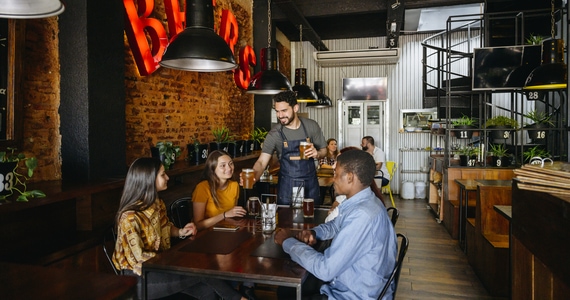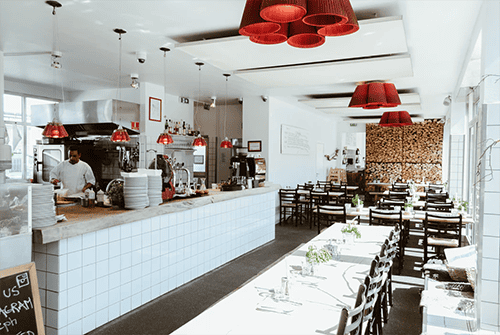What to plan before visiting these buzzed-about Restaurants in 2023
Eating Thrills: Check Out Cutting-edge Restaurants Transforming the Food Scene
The modern eating landscape is experiencing an amazing improvement, marked by innovative dining establishments that are redefining culinary norms. From the rise of pop-up establishments embracing seasonal ingredients to immersive experiences that involve the detects in unprecedented ways, these venues are setting new standards for what it implies to appreciate a dish. Additionally, a growing emphasis on sustainability and local sourcing mirrors a commitment to both top quality and neighborhood. As we discover these fads, the question occurs: what future growths might further improve our culinary experiences?
The Surge of Pop-Up Restaurants
As the cooking landscape progresses, pop-up restaurants have become a dynamic pressure, captivating food fanatics and business owners alike. These momentary eating establishments, commonly established in unique areas, use a distinct mix of creative thinking and availability, appealing to a diverse series of consumers. The rise of pop-up dining establishments can be attributed to a number of aspects, consisting of the growing demand for unique dining experiences and the entrepreneurial spirit of chefs keen to evaluate their cooking ideas without the monetary problem of an irreversible location.Pop-up dining establishments allow chefs to trying out menus, styles, and motifs, usually concentrating on seasonal or locally-sourced ingredients. This adaptability not just fosters innovation yet likewise creates a sense of urgency, as clients are attracted to the limited-time offerings. The ephemeral nature of pop-ups grows a buzz around the eating experience, encouraging social networks sharing and word-of-mouth promotion, which can considerably boost presence and draw in a dedicated following.Furthermore, pop-up restaurants commonly cater to specific niche markets, varying from vegan and gluten-free alternatives to ethnic foods, thus fulfilling the varied nutritional preferences of modern-day customers. Therefore, these facilities add to the rich tapestry of the food scene, pressing limits and tough conventional ideas of dining.
Immersive Eating Experiences

Sustainable Practices in Food
Embracing sustainability, innovative restaurants are redefining their cooking techniques to reduce ecological impact while improving the eating experience. These facilities prioritize neighborhood sourcing, frequently teaming up with close-by farmers and producers to assure that ingredients are fresh and seasonal. This not just decreases the carbon impact linked with long-distance transport but likewise sustains local economies.In addition to sourcing, dining establishments are significantly taking on practices that minimize waste. Many are implementing composting systems and using food scraps creatively, changing what would typically be thrown out into delicious elements of new dishes. For instance, veggie trimmings can locate brand-new life in stocks or garnishes, while stale bread is repurposed right into croutons or bread puddings.Moreover, the fad in the direction of plant-based menus is getting energy (Best Restaurants). By stressing veggies, grains, and legumes, dining establishments can significantly reduce their environmental influence, as plant-based foods normally need less sources and produce less greenhouse gas discharges compared to meat manufacturing. Cutting-edge chefs are crafting meals that not just celebrate these components however also supply restaurants with an outstanding cooking experience.Furthermore, lots of facilities are embracing environment-friendly methods such as using eco-friendly product packaging for takeout and investing in energy-efficient appliances. These actions show a dedication to sustainability at every level of operation, permitting restaurants to enjoy their meals with the understanding that their selections add to a healthier planet. As the food scene proceeds to develop, the integration of lasting practices becomes not simply a pattern, but a necessary standard for the future of dining
Tech-Enhanced Eating Experiences
Tech-enhanced eating journeys are revolutionizing the way clients experience meals, with over 70% of restaurants now including digital technologies to elevate service and interaction. These innovations are not merely trends; they are fundamental changes that redefine the culinary landscape. From the minute diners go into a restaurant, innovation is seamlessly woven into the experience, boosting both convenience and enjoyment.One of one of the most remarkable developments is using mobile applications for bookings and food selection surfing. Restaurants can currently view comprehensive summaries, nutritional information, and even the origins of components at their fingertips. This transparency promotes informed selections and permits visitors to customize their eating experience to their preferences.Furthermore, interactive tables geared up with touchscreens give an engaging platform for getting and enjoyment. Restaurants can personalize their meals, check out a glass of wine pairings, and even play video games while awaiting their meals. This combination of modern technology not just enhances the buying process but also transforms eating right into a dynamic, communal activity.Moreover, some facilities are using enhanced truth (AR) to create immersive eating experiences. By just directing a mobile phone at a dish, clients can envision the ingredients and cooking techniques in an engaging way, linking the void in between the culinary and digital worlds.As restaurants continue to accept these technological technologies, the eating experience becomes progressively individualized, efficient, and satisfying. This makeover reflects a more comprehensive trend in the direction of boosting customer involvement, ensuring that each meal is not practically nourishment, yet an unforgettable experience in dining.
Global Tastes With a Twist
The cooking landscape is progressively marked by combination food advancements that mix traditional flavors with unanticipated components - Restaurants. One-of-a-kind active ingredient pairings not just improve the dining experience yet also pay homage to cultural heritage, reimagining cherished recipes in interesting brand-new methods (American Restaurant). This creative approach welcomes diners to discover varied worldwide impacts while experiencing acquainted preferences in a fresh context
Combination Food Innovations
Creative thinking in the cookeries has actually led to a dynamic rebirth of fusion food, where cooks mix diverse international tastes to create cutting-edge meals that defy typical limits. This cooking movement transcends plain mix, concentrating on the unified integration of active ingredients and strategies from various cultures.Restaurants focusing on combination food are redefining eating experiences by presenting dishes that narrate through taste, technique, and presentation. The marriage of Japanese sushi with Peruvian ceviche has resulted in special rolls that commemorate both cooking heritages. Similarly, Indian flavors have actually located their means right into Italian pasta recipes, offering a delightful spin on classic recipes.Chefs are also experimenting with food preparation approaches, such as utilizing typical frying pan techniques to prepare Latin American stir-fries, thus creating an abundant tapestry of tastes and structures. Seasonal schedule of active ingredients better boosts this innovative process, enabling fresh analyses of time-honored meals. The appeal of fusion food depends on its ability to shock and joy the taste, urging restaurants to discover new cooking landscapes while promoting a better admiration for the diversity of global gastronomy.
Distinct Active Ingredient Pairings
Culinary innovation often flourishes on the unexpected, and one-of-a-kind component pairings are at the leading edge of this trend in the contemporary eating landscape. Cooks are increasingly trying out combinations that shock and delight the taste, raising the dining experience past traditional boundaries.For example, the association of sweet and full-flavored has ended up being a hallmark of contemporary cuisine. Breakfast Served Near Me. Consider crunchy duck offered with a cherry and balsamic glaze, where the tartness of the cherries complements the richness of the meat. Dishes including miso-infused chocolate desserts display how umami can boost sweetness, producing a balanced taste profile that intrigues diners.Furthermore, the usage of unusual flavors in unanticipated contexts, such as saffron in a traditional risotto matched with lemon passion, highlights exactly how culinary limits can be redefined. These ingenious pairings not just produce aesthetic and textural contrasts but additionally welcome diners to check out a spectrum of international tastes in a solitary dish.As restaurants continue to forge ahead, the excitement of uncovering new tastes through one-of-a-kind ingredient pairings guarantees to be a defining feature of the modern-day food scene, inviting daring eaters to delight in these creative culinary discussions
Cultural Heritage Reimagined

The Art of Multi-Sensory Foods
In the domain of cooking advancement, multi-sensory meals are revolutionizing the dining experience by linking taste and fragrance in charming means. The influence of aesthetic presentation boosts not simply the aesthetic appeal but likewise the understanding of preference, while thoroughly curated soundscapes raise the setting. Together, these components create an all natural experience that engages all senses, changing exactly how clients get in touch with food.
Flavor and Aroma Fusion
A growing variety of cooks are welcoming the principle of taste and aroma combination, acknowledging that a dish is not just a mix of ingredients yet a holistic experience that engages all the detects. This cutting-edge strategy stresses the complex relationship between taste and smell, both of which significantly influence our understanding of food.Chefs are try out different methods to improve flavors while at the same time crafting fragrant accounts that elevate the eating experience. For example, making use of aromatic natural herbs and spices not only includes deepness to meals however likewise tantalizes the olfactory senses, creating an extra immersive experience. Mixtures, smoke, and important oils are progressively preferred, enabling chefs to adjust scent and improve the general flavor profile.Moreover, the calculated pairing of complementary and different flavors can evoke emotional actions, changing a dish right into an unforgettable event. Restaurants are motivated to enjoy each bite, as the interplay of flavors and scents unfolds, welcoming them to discover new dimensions of preference. This thoughtful amalgamation of sensory aspects cultivates a recognition for the artistry of food, positioning taste and aroma blend as an essential trend in contemporary gastronomy.
Visual Discussion Impact
Beyond flavor and fragrance, the visual discussion of a meal plays an important role in the general dining experience. The looks of food can evoke feelings, set the tone for the meal, and enhance the expectancy of tasting. Innovative dining establishments are progressively identifying that a recipe's appearance can influence visitors' assumptions and complete satisfaction levels, occasionally also before the first bite is taken.Artful plating strategies, dynamic color mixes, and innovative garnishes add to a meal's visual attraction. Cooks are currently educated not simply in cooking abilities, yet also in the art of discussion, frequently drawing motivation from different artistic techniques. The use of negative area in plating assists to create focal factors, enabling the components to shine.Moreover, the pattern of multi-sensory dishes integrates aesthetic components with various other detects, such as structure and temperature, to produce a holistic dining experience. This method motivates diners to engage more deeply with their food, changing an easy meal right into an unforgettable event. Basically, the visual presentation of food is not simply an aesthetic undertaking; it is a vital part of the eating experience that can raise a meal from regular to extraordinary.
Soundscapes in Dining
The experience of eating expands beyond the visual elements of a meal; noise also plays a significant role fit how food is viewed and delighted in. Innovative dining establishments are significantly discovering the concept of soundscapes-- curated audio atmospheres developed to improve the eating experience (Eddie's Rise N' Dine Williamsville IL). The interaction of sound and taste can exceptionally affect a person's understanding of flavor, texture, and general satisfaction.Research suggests that certain sounds can magnify or decrease flavors. As an example, piercing sounds may boost sweetness, while reduced regularities can enhance anger. This phenomenon has actually led some cooks and restaurateurs to collaborate with audio developers, producing special auditory backgrounds that match their cooking offerings. Best Restaurants.In these settings, restaurants may discover themselves involved in a carefully crafted audio setting, varying from the gentle rustle of fallen leaves to the balanced audios of a dynamic kitchen area. Such multisensory dishes not just engage the palate but likewise stimulate emotional reactions, enhancing the general experience. By harnessing the power of sound, these ingenious eating facilities are redefining the way we experience food, motivating patrons to savor each bite while totally engaging their detects
Community-Centric Culinary Initiatives
Frequently, cutting-edge dining establishments are redefining their duties within neighborhood areas by implementing cooking campaigns that focus on social responsibility and inclusivity. These establishments are progressively appealing in practices that not just boost their company versions yet also add to the well-being of their neighborhoods.One noticeable fad is the establishment of neighborhood kitchen areas that supply culinary training and work positioning for underserved populations. These cooking areas not only supply important abilities yet likewise foster a sense of belonging, equipping people to produce their very own culinary paths. Furthermore, lots of dining establishments are partnering with neighborhood ranches and manufacturers, emphasizing farm-to-table methods that sustain lasting farming and minimize carbon impacts. This not only ensures quality and high quality but additionally reinforces neighborhood economies.Another campaign getting grip is the concept of public eating experiences, where varied teams come with each other to share dishes and stories. This technique grows understanding and admiration among different societies, damaging down barriers and promoting inclusivity. Restaurants are progressively taking on waste decrease approaches, such as composting and recycling food scraps, which not only addresses ecological issues but likewise motivates customers to show on their usage habits.
Regularly Asked Questions
How Do Cutting-edge Restaurants Keep Consistency in Food Quality?

What Are the Prices Linked With Starting a Pop-Up Restaurant?
Starting a pop-up my company restaurant includes numerous prices, consisting of place leasing, equipment acquisitions, permits, advertising and marketing, staffing, and food materials. Additionally, entrepreneurs must allocate unexpected costs to ensure smooth operations throughout the endeavor's period.
Exactly How Do Dining Establishments Select Their Locations for Pop-Up Occasions?
Restaurants pick pop-up event places based upon target demographics, foot web traffic, access, and competitors. Additionally, they take into consideration neighborhood market fads and area engagement chances to make best use of visibility and enhance customer experience throughout the occasion.
What Effect Do Food Trends Have on Dining Establishment Menus?
Food patterns substantially affect restaurant menus by directing ingredient choice, influencing recipe creativity, and forming customer preferences. Establishments usually adjust to these patterns to boost client allure, keep competition, and straighten with advancing cooking assumptions.
Exactly How Can Diners Support Community-Centric Culinary Initiatives?
Restaurants can sustain community-centric culinary efforts by purchasing from regional dining establishments, joining farm-to-table events, involving with food cooperatives, promoting lasting practices, and supporting for plans that reinforce neighborhood food systems and boost neighborhood well-being.